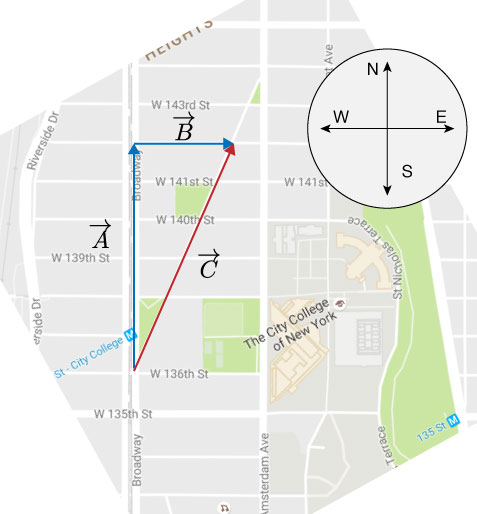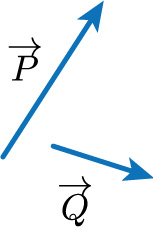Math, Trigonometry and Vectors
Geometry
What is the angle $\beta$ equal to?
Trigonometry
Trig Definitions
Here's a familiar image.
This one might be a little less familiar, but the same rules apply.
Inverse functions
We can also use the inverse trigonmetric functions.

It's 450 meters from the corner of Hamilton Place and Broadway to 142nd St and Broadway. It's 489 meters from the same corner to 142nd if you walk along Hamilton Place. a) What is the angle between Hamilton and Broadway?
Pythagorean Theorem
We'll use this relationship all the time.
$$a^2 + b^2 = c^2$$.
It's 450 meters from the corner of Hamilton Place and Broadway to 142nd St and Broadway. It's 489 meters from the same corner to 142nd if you walk along Hamilton Place. b) How far is it from Broadway to Hamilton Pl. walking along 142nd St?
Scalars and Vectors
These are two different mathematical or physical entities.
Scalars: A scalar quantity is completely specified by a single value with an appropriate unit and has no direction. (e.g. $20)
Vectors: A vector quantity is completely described by a number and appropriate units plus a direction. (e.g. person walks 2 km E)
Some Examples:
Scalars: Temperature, Speed, Distance, length, density
Vectors: Displacement, Velocity, Force, Weight
Vector vs. Scalar example
A particle travels from A to B along the path shown by the dotted red line. This is the distance traveled and is a scalar
The displacement (change in position) is the solid line from (a) to (b). The displacement is independent of the path taken between the two points displacement is a vector (it has length and direction).
Notation
When writing math by hand, just put an arrow on top of the variable. This will indicate it is a vector: $\overrightarrow{A}$
In printed text, you'll see vectors either in bold face: $\mathbf{A}$ or with an arrow: $\overrightarrow{A}$
If we want to refer to the magnitude only of a vector quantity, we can use absolute value bars: $|A|$, or just in italics: $A$.
Properties of vectors
Two vectors are equal if they have the same magnitude and the same direction
$\mathbf{A} = \mathbf{B}$ if $|A| = |B|$ and they point along parallel lines
All of the vectors shown are equal in magnitude and direction, thus they are equal.
Addition of Vectors
Adding two scalar quantities is easy. We just add them like we would add any normal quantity.
However, vectors involve more math. We have to also take into account which way they are pointing.

Imagine we walk along two displacement vectors $\overrightarrow{A}$ and $\overrightarrow{B}$. What is the resultant displacement? Or, what is $\overrightarrow{A} + \overrightarrow{B}$?
Vector Addition: Graphically
To add $\overrightarrow{A} + \overrightarrow{B}$
- Arrange the vectors tip to tail.
- Connect the tip of $\overrightarrow{A}$ to the origin of $\overrightarrow{B}$.
Link to Vector Addition Sim.
Vector Addition: Sim
The two blue vectors are added together resulting in the black-dashed vector. You can drag each of the blue ones around, change its magnitude and direction, and observe the change in the resultant.

Which of the following is the resultant for $\overrightarrow{P} + \overrightarrow{Q}$?

Negative of a Vector
The negative of a vector is simply a vector with the same magnitude, but pointed in the opposite direction.
The resultant of $\overrightarrow{A} + (-\overrightarrow{A}) = 0$
Vector Subtraction
To Subtract two vectors, say $\overrightarrow{A} - \overrightarrow{B}$, all we need to do is add the negative of $\overrightarrow{B}$ to $\overrightarrow{A}$.
Since, $\overrightarrow{A} - \overrightarrow{B} = \overrightarrow{A} + (-\overrightarrow{B})$
 Which of the following is the resultant for $\overrightarrow{P} - \overrightarrow{Q}$?
Which of the following is the resultant for $\overrightarrow{P} - \overrightarrow{Q}$?

Multiplication of a Vector times a Scalar
The result of the multiplication or division by a scalar is a vector.
The magnitude of the vector is multiplied or divided by the scalar.
Vector Components
The components of a vector are the parts of a vector that point along a given axis. We'll use the Cartesian Coordinate System most often.
Here we see the $x$ and $y$ components of the vector $\mathbf{A}$.
We can see that the $x$ component, $\mathbf{A}_x$, points all along the $x$ axis, while the $y$ component, $\mathbf{A}_y$, points only along the $y$ axis.
Here's another vector $\mathbf{A}$ decomposed into its $x$ and $y$ components.
Here is a vector and its x and y components. Change the vectors magnitude and direction and observe the components.
Here are the components of $\mathbf{R}$:
$$R_x = +4, R_y = +3$$Which diagram represents $\mathbf{R}$?
We can use these vector components to add two arbitrary vectors together. (notice that $\mathbf{A}$ and $\mathbf{B}$ are not at right angles to each other.)
We'll combine the components of $\mathbf{A}$ and $\mathbf{B}$ to get the components of $\mathbf{C}$.
$$\mathbf{C}_x = \mathbf{A}_x+\mathbf{B}_x$$ $$\mathbf{C}_y = \mathbf{A}_y+\mathbf{B}_y$$Once we have the components of $\mathbf{C}$, we can use the pythagorean theorem to get the magnitude of $\mathbf{C}$.
$$|C| = \sqrt{C_x^2+C_y^2}$$A car travels 20 km due N and then 35 km in a direction 60º W of N. Find the magnitude and direction of the car’s resultant displacement.
Unit vectors
A unit vector is a vector that has a magnitude of exactly 1, and points in a given direction.
Function of Unit vectors
Rather than always using the $\theta$ and magnitude of a vector to describe it, we can use the unit vectors.
$\mathbf{A} = A_x \hat{\mathbf{i}} + A_y \hat{\mathbf{j}}$
$\mathbf{A} = 5 \hat{\mathbf{i}} + 3 \hat{\mathbf{j}}$
Dot Product
There are two ways of multiplying vectors:
1. The dot product (or scalar product)
$\mathbf{a} \cdot \mathbf{b} = a b \cos \theta$
$\mathbf{a} \cdot \mathbf{b} = (a_x \hat{\mathbf{i}}+a_y \hat{\mathbf{j}}+a_z \hat{\mathbf{k}})\cdot(b_x \hat{\mathbf{i}}+b_y \hat{\mathbf{j}}+b_z \hat{\mathbf{k}}) $
$\mathbf{a} \cdot \mathbf{b} = a_x b_x + a_y b_y + a_z b_z$
Cross Product
The second method produces another vector:
2. The cross product (or vector product)
$|\mathbf{a} \times \mathbf{b}| = a b \sin \phi$
This produces a third vector that points perpendicular to both the original vectors.
$\mathbf{a} \times \mathbf{b} = (a_x \hat{\mathbf{i}}+a_y \hat{\mathbf{j}}+a_z \hat{\mathbf{k}})\times(b_x \hat{\mathbf{i}}+b_y \hat{\mathbf{j}}+b_z \hat{\mathbf{k}}) $
Graphs & Plots
Visual Information is Powerful.
Functional Relations
-
Constant
-
Linear
What is the sum of vectors $\mathbf{A} + \mathbf{B} + \mathbf{C} +\mathbf{D}$?
- $\mathbf{R}$
- $\mathbf{-R}$
- $\mathbf{G}$
- $\mathbf{-G}$
- 0